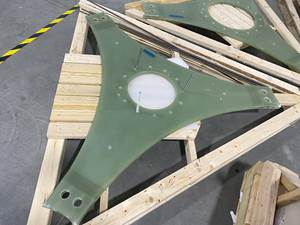What will be the next major iteration in carbon fiber?
A consultant and the president of Dayton, Ohio-based Quickstep Composites, the U.S. subsidiary of Australia-based Quickstep Technologies (Bankstown Airport, New South Wales), Dale Brosius surveys the carbon fiber horizon for signs of what carbon fiber types will be pre-eminent.
In 1984, I moved from a job as a production engineer responsible for day-to-day operations of a very large chemical manufacturing unit in Texas to doing market development of automotive composites in Detroit, both with The Dow Chemical Co. (Midland, Mich.). In Texas, I became familiar with composites, typically glass/epoxy or glass/vinyl ester for corrosion-resistant applications, such as tanks and piping. Upon arrival in Detroit, I was introduced to carbon fiber, because Dow supplied the resin used to manufacture carbon fiber composite driveshafts for the Ford Econoline van. Then (and still, for the most part), carbon was entirely too expensive for widespread use in automobiles, but it nevertheless offered fantastic strength and stiffness at very low weight. Unfortunately, the driveshaft went out of production a few years later.
After four years, I moved to Fiberite, at the time the world’s largest intermediate processor of carbon fiber, and now part of Cytec Industries (Woodland Park, N.J.). At that point, my narrow interpretation of carbon fiber as standard-modulus PAN expanded immensely! My sales territory included fabricators of sporting goods, satellite structures and solid rocket motor manufacturers like Morton Thiokol (now part of ATK, Ogden, Utah), which built the boosters for the Space Shuttle. Sporting goods companies used cheaper standard-modulus PAN prepreg (cheap being a relative term, of course).
The first order I took for satellite structure prepreg used Amoco’s Thornel UHM P-120 fiber (Amoco’s fiber also became Cytec’s). This pitch-based material was priced at more than $2,000/lb ($4,400/kg)! This was my first introduction to pitch fiber, and clearly I had hit the other end of the carbon fiber spectrum. Although P-120 orders were few and far between, I became familiar, shortly thereafter, with carbon fiber/phenolic prepregs using fibers based on viscose rayon. Developed in the late 1950s, rayon fibers predated PAN (1961) and pitch fibers (1970). They are still widely used as the ablative insulation for exit cones of solid-propellant rockets, having replaced fiberglass/phenolic in that application. In the 1980s, a big effort to replace rayon with PAN fibers in exit cones met with limited success, given the low thermal conductivity and superior ablation performance of rayon-based carbon prepregs.
That’s where we stand today: Three commercial precursors, with dominant PAN holding a 90 percent market share. A lot has changed since 1988, with new market entrants, globally, and rapid growth of the carbon fiber market, driven by increased aerospace use and growing industrial acceptance. The future of large-tow (>24K) fiber is assured, following Toray’s purchase of Zoltek in 2013, and Cytec’s July announcement of its intent to enter the large-tow market. And increasing use in the automotive (finally!) and wind energy sectors is driving capacity expansion everywhere.
So what’s next? A prominent option is to drive the cost out of industrial-grade carbon fiber, which is being approached from multiple angles. The logical starting place is PAN fiber. Today’s production lines typically range from 1,500 to 3,000 tons/yr, so going to lines in the 5,000- to 6,000-ton range might cut costs a little. Alternate conversion techniques that use less thermal energy (e.g., microwave or plasma) are under exploration. So are true “textile-grade” precursor fibers and melt spinning of the PAN polymer vs. the energy-intensive solution-spinning process used today.
But what if the answer lies in a different precursor? More than a decade of research has gone into developing carbon fiber using lignin, a low-cost paper-industry byproduct. Although it is an attractive sustainable/renewable resource, raw lignin is quite variable and requires purification to make a polymer that can be spun into a fiber, adding considerably to cost. The product forms and properties of the resulting fiber continue to improve but, to date, are still well short of PAN-based carbon fiber. Polyolefins, such as polyethylene (PE), offer the potential for up to 86 percent conversion to carbon fiber (vs. PAN at 50 percent), according to Dow Chemical, but the conventional route to PE fibers that can be properly carbonized involves treatment with chlorosulfonic or sulfuric acid prior to conversion. Although a non-acidic route is being explored, it’s still in the early stages. Successfully developed, lignin or polyolefin precursors might offer the opportunity to finally reach the magic $5/lb ($11/kg) target.
Meanwhile, researchers at Carbon Nexus (Geelong, Australia) are looking past precursor changes, exploring ways to improve carbon composite properties, especially shear and compressive strength. One approach is to adhere carbon nanotubes to individual filaments of conventional PAN fibers. I’m guessing this won’t be “cheap” and, likely, will be of greatest interest to the aerospace community.
Chances are, the carbon fiber market will be 10 times larger a decade from now, so there is ample room for new precursors and product forms. And I’m pretty certain there will still be a rayon niche in whatever mix occurs.
Quickstep Composites LLC
Related Content
Honda begins production of 2025 CR-V e:FCEV with Type 4 hydrogen tanks in U.S.
Model includes new technologies produced at Performance Manufacturing Center (PMC) in Marysville, Ohio, which is part of Honda hydrogen business strategy that includes Class 8 trucks.
Read MoreRTM, dry braided fabric enable faster, cost-effective manufacture for hydrokinetic turbine components
Switching from prepreg to RTM led to significant time and cost savings for the manufacture of fiberglass struts and complex carbon fiber composite foils that power ORPC’s RivGen systems.
Read MoreAchieving composites innovation through collaboration
Stephen Heinz, vice president of R&I for Syensqo delivered an inspirational keynote at SAMPE 2024, highlighting the significant role of composite materials in emerging technologies and encouraging broader collaboration within the manufacturing community.
Read MoreHow composites have become a necessity
Composites used to be one of many material options across industries and applications, but that's not the case anymore.
Read MoreRead Next
Developing bonded composite repair for ships, offshore units
Bureau Veritas and industry partners issue guidelines and pave the way for certification via StrengthBond Offshore project.
Read More“Structured air” TPS safeguards composite structures
Powered by an 85% air/15% pure polyimide aerogel, Blueshift’s novel material system protects structures during transient thermal events from -200°C to beyond 2400°C for rockets, battery boxes and more.
Read MorePlant tour: Daher Shap’in TechCenter and composites production plant, Saint-Aignan-de-Grandlieu, France
Co-located R&D and production advance OOA thermosets, thermoplastics, welding, recycling and digital technologies for faster processing and certification of lighter, more sustainable composites.
Read More





















